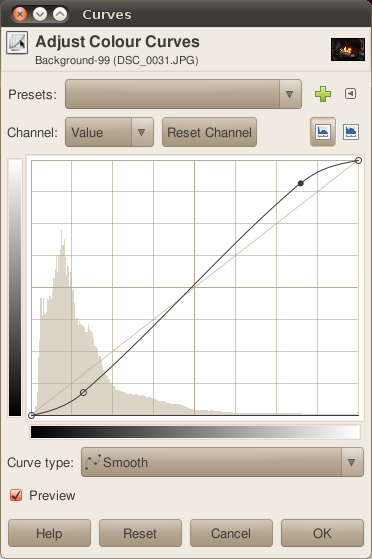

Here's what would have happened if we had missed step 3: Create Selection From Path This is where we specified what direction the path was going to take, and how sharp the angle was going to be. In this example, I wanted another curve, so I clicked and dragged:

For example, in the following image, the top handle is perpendicular to the other handle - it's roughly at a 90 degree angle. You create corners by simply moving the handle across. The curve will be going in one direction, but you need to change it with a sharp angle. Often when you draw a path, you will need to create a corner immediately after a curve.

This is to faciliate the differently shaped curves on each side of the anchor. On the right image, the handles are different sizes (the lower handle is shorter). Also, both handles on the left image are roughly the same size. On the left image, the large, outer curve needs larger handles than the smaller inner curve (on the right image). You can see that on both curves, the handles are straight (or almost straight). The left image highlights the handles at the bottom, inner curve of the shape. The right image highlights the handles at the top left of the shape. Three factors impact on getting a good curve with the Path tool: But drawing an accurate curve is not as difficult as it may seem. When creating curves, beginners often find that it's difficult to control exactly where the path runs.
GIMP CURVE TEXT HOW TO
This is because they create too many anchor points and don't know how to get a proper curve. Many beginners tend to create jagged curves that aren't smooth. Other anchors represent a sharp change in the direction of the path (for example, at the tip of the leaf). Some anchors are located along a long smooth curved line.

Now, take a look at the anchors in the following image. Learning where to place anchors, and how to control them is a crucial part of learning the Path tool. Take time to practice it, and before long, you will find it as easy as any other tool. Using the path tool can be a little tricky when you first start out. Of course a highly skilled painter could draw it with a real brush, even with a graphic tablet, but you had excluded those options.Now that we've learned what the path tool is, let's learn how to draw paths with it. Even more complex, no way to apply a drawn path. You can also apply curve bend filter or cage transform. You can define simulated pressure dynamics which tapers the brush and stroke a path with it. In Illustrator and Affinity Designer it can even be a photo. Vector drawing programs have quite usable tools for bending a shape along a path. Then a couple of curves were drawn, their strokes were defined to be the content of the clipboard. It's from Inkscape.Ī horizontal triangle was drawn and copied to the clipboard. As well you can convert it to a selection and fill the selected area with a color.ĪDD: The following is much easier in vector drawing software. In bitmap editors (GIMP, Photoshop) you can define the path to be a clipping mask of a colored layer.
GIMP CURVE TEXT SOFTWARE
These are also essential skills in vector drawing software (Illustrator, Inkscape) You can insert and remove the nodes, move them and adjust the handles. Corner points are made by clicking and the nodes with tangent handles are made by dragging and holding the mouse button at the same time. In GIMP or Photoshop you can draw a closed path. It's not a curve which has varying width altough in vector drawing programs also that is possible.


 0 kommentar(er)
0 kommentar(er)
